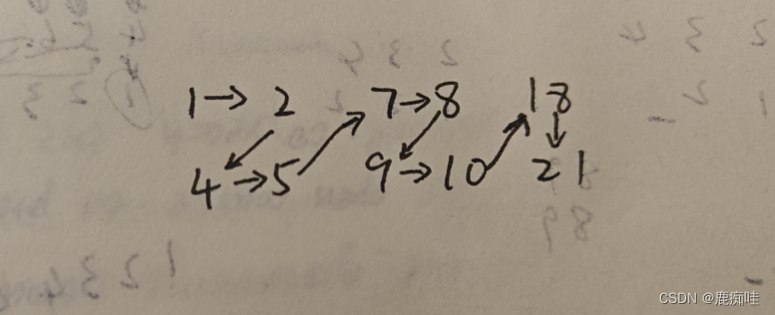合并有序链表
- 图解
- 代码如下
图解
虽然很复杂,但能够很好的理解怎么使用链表,以及对链表的指针类理解

代码如下
Node* merge_list_two_pointer(List& list1, List& list2)
{Node* new_head1 = list1.head;Node* new_head2 = list2.head;Node* sentinel1 = list1.head;Node* sentinel2 = list2.head;Node* temp_head1 = NULL;Node* temp_head2 = NULL;int flage = 1;//因为下面是<=,所以以list2优先为空if (new_head1->data >= new_head2->data){flage = 2;}while (new_head1 != NULL && new_head2 != NULL){while (list1.head != NULL && list1.head->data < list2.head->data){temp_head1 = list1.head;list1.head = list1.head->next;}//正常两个有序列表,上面为空,//456,123456789if (list1.head == NULL && flage == 2){temp_head1->next = list2.head;return sentinel2;}//特殊情况列表,全大//123,456if (list1.head == NULL){temp_head1->next = new_head2;return sentinel1;}if (temp_head1 != NULL){temp_head1->next = new_head2;}while (list2.head != NULL && list2.head->data <= list1.head->data){temp_head2 = list2.head;list2.head = list2.head->next;}//正常两个有序列表,下面为空//123456789,456if (list2.head == NULL && flage == 1){temp_head2->next = list2.head;return sentinel1;}//特殊情况列表也就是,全小//456,123if (list2.head == NULL){//防止89,89这种类型链表跑空temp_head2->next = list1.head;return sentinel2;}//这里不需要判断这个为空。如果为空,则说明已经到达链表尾部temp_head2->next = list1.head;new_head1 = list1.head;new_head2 = list2.head;}
}


 JSX 的转换 jsx到底是什么?React是如何把jsx转换为ReactElement?)

)









)

)


